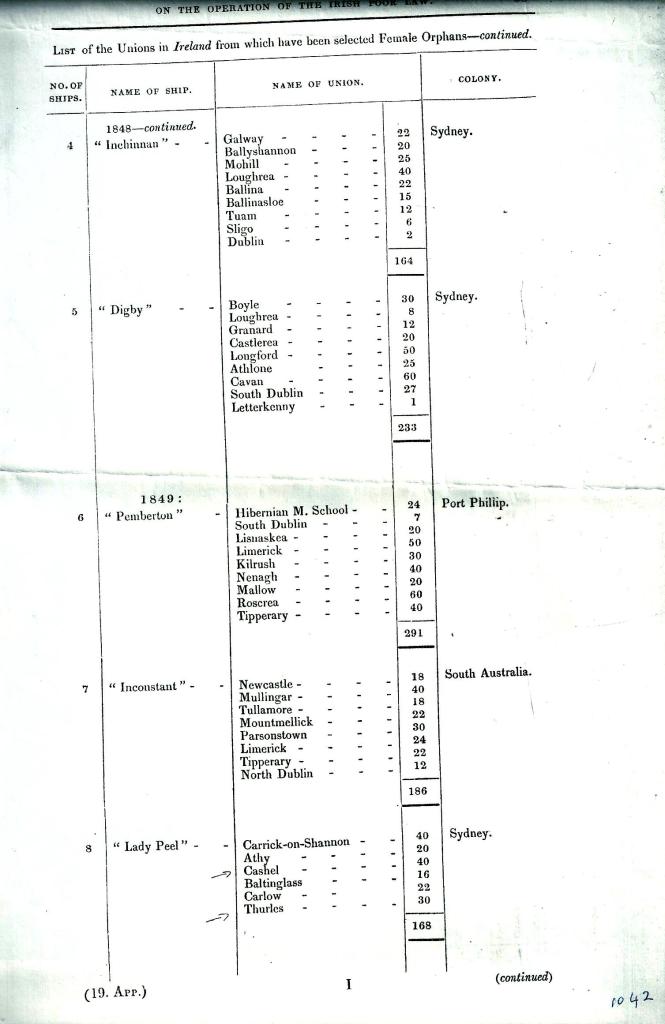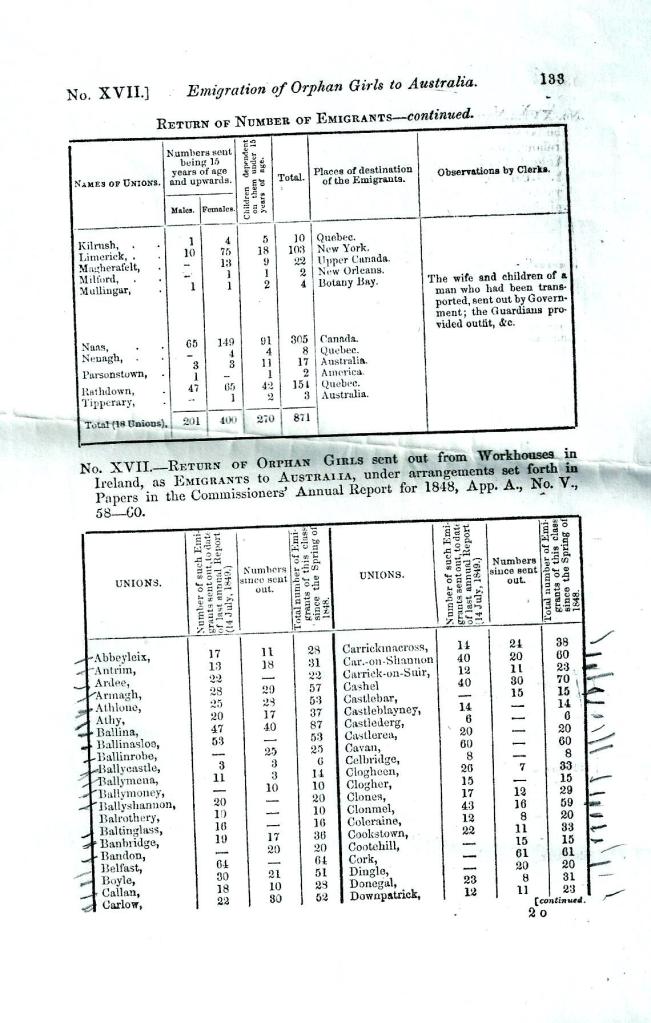British Parliamentary papers:
female orphan emigration returns
These scans of xerox copies I made in c. 1980 may prove useful to some people. I recently found them among my research notes on Cartesian philosophers!
The first document is from the Select Committee of the House of Lords appointed to inquire into the operation of the Irish Poor Law, and the expediency of making any amendments to its enactments. Sixth Report. Appendix to Minutes of evidence, BPP HC 1849-49, vol 16, No. 507, pp.64-66. It tells us which Irish Poor Law Unions the orphans came from and which ship they traveled on.
You will notice the misinformation regarding the first two vessels. Unfortunately it does not include information about vessels that arrived later, in 1850.
The appendix is online here somewhere but I haven’t been able to find the exact page,
http://www.dippam.ac.uk/eppi/documents/12556
The next document is from BPP HC 1850 (XXVII) Commissioners for administering Laws for the Relief of the Poor in Ireland. Third Annual Report Appendix B pp.132-34 . You will notice this is where the figure 4114 female orphans comes from but my Barefoot, vols I and II has slightly more, about 4150, from memory. I assume the number in the database will be closer to the second figure. Please excuse my shonky scanning.
Luckily nowadays one can gain access to these things online. Try
http://www.dippam.ac.uk/eppi/documents/12752/page/322956
Which reminds me…I’ve been hearing people say things like many of the orphans married more than once or the orphans often married more than once. Both ‘many’ and ‘often’ imply a measure. I was wondering has anyone actually counted or is it just a general impression, even an anecdotal one? Is it one in five, or 100 out of 300, or 400 out of 4000? And what percentage of marriages is each of these?
I’m having a little trouble with my post on the ending of the Earl Grey scheme. Soon come.
Glac bog an saol agus glacfaidh an saol bog tú …which reminds me of Yeats’s “tread softly for you tread …”






Hi Trevor, I am really new to this so have MOST of your blogs as well as the wealth of other material to catch up on. I knew my ancestor came as an orphan, but didn’t know it was a programme until I was watching back issues of “Who Do You Think You Are?” It twigged that my 2xggm came on the Earl Grey as a 17 year-old in 1848. I have known that for many years. I am certain of her marriage and death records and notice your family reconstruction suggestions. That has all been pored over endlessly because we have a mushroom cloud of DNA verified descendants who have researched various lineages. There are a lot of mistakes as you can appreciate from the cut/paste type genealogy you get on sites like Ancestry, but with a little care you can see the wood for the trees. What I want to verify is her movements between her leaving her indentured employer, most probably at the end of 1849 or therabouts and turning up getting married in Wellington on the 7th of July 1851. Mostly, the shipping lists were listed in a syndicated column called “Shipping Intelligence” but sometimes the movements across the Tasman weren’t listed. just numbers. Have you any suggestions for records I might try. I am keen to make her case rock solid (It is the researcher in me). I might add, I think she may have had a decent life, as opposed to a lot of these girls. She was much loved and respected. She was literate, her many babies survived infancy.
Best regards
Catherine Davies
LikeLike
Just a quick reply, have you checked the database at http://www.irishfaminememorial.org
Do your BDM records or anything else tell you the names of her parents? And do they accord with what’s on that database? It would confirm you have the right person. Maybe try Trove too. Any military records if perhaps she married a soldier who moved. Did she move with a new employer? It might be very difficult to find details of her move but right name, age, religion, parents names should give you enough confidence in your findings. Best wishes, Trevor
LikeLike
Catherine, I see i didn’t really suggest anything valuable. If you cannot see her on any shipping lists either here or in NZ, or in any newspaper, there isn’t a great deal of hope. Unless there is mention of how and why she crossed the Tasman in some family’s records, we’re reaching for straws. Did you check my blog post 22 i think it is on Cancelled indentures to see if there is a record of her indenture being cancelled. May i ask her name?
Trevor
LikeLike
Hi Trevor,
Mary Ann Matthews. She married William Henry Jones III, a grandson on John Gowen (first fleet marine, later landowner Norfolk Island, later Government Storekeeper at Parramatta (1822). His grandmother was Ordery Appleyard, a convict who arrived in 1801 aboard the Earl of Cornwallis. William Henry Jones III was born in India where his father, a British soldier, William Henry Jones II was posted after he married Mary Gowen. He returned to Brisbane (after ten years, and then time in Gibraltar) with a pension and a job as a barracks sergeant. In 1848 he was transferred to Wellington, however the family retained deep roots in NSW. WHJ (2) name appears on the ships passenger manifest, but not his son (WHJ III, by then 19). The marriage was July 7th 1851 in the Wesleyan Chapel, Wellington. They had the first of their 13 children the following year. All but one survived infancy and eleven outlived Mary Ann (whomust have been known just as Mary as that is what is on her headstone) who died in 1909. They lived on an acre block LittleTaranaki Place, now Inglewood Place, in the centre of Wellington. She is buried in the Bolton St Cemetery.
I think I need to comb the shipping lists, well, just differently. Also, I think it might be fruitful to look at John Gowen’s other children and what they were up to at the time.
Catherine
LikeLike
Catherine,
It may worth getting in touch with http://www.irishfaminememorial.org via their contact link. Or indeed alerting the students who are just finishing their internships at MAcquarie University; they have been working on the orphans. Tanya Evans is in charge, i believe. Basically just to see if they have any ideas. I could give them your email address if you wish. Best wishes
Trevor
LikeLike
The BPP documents are invaluable _I’ve used them for census comparisons but not for this purpose here.
LikeLiked by 1 person
Thanks trevor your work is amazing!!
LikeLike
THanks Kaye. It looks like there isn’t a lot specifically related to Margaret’s Irish background. You may have to imagine it for yourself. I hope there is something in my early blog posts, at least up to post seven or eight, that will help you do that. Maybe also find out what you can about Tipperary Town during the Famine? Best of luck with it.
LikeLike
Thank you Kaye and Trevor! Do either of you know of documents that describe how Surgeon Superintendents were chosen, and who made each choice, for each of the Earl Grey ships?
LikeLike
Becky,
Robin Haines, Doctors at Sea, Palgrave, 2005 will give you a good history, and analysis of the importance of the Surgeons to the Australian voyages in all. Basically the Emigration Commissioners chose the surgeons. Some surgeons only made the one trip and settled in Australia, others made many, Strutt for example continued as a SS until he was 62yo. The Commissioners built up a register of doctors they could use, some naval surgeons, some private. They even sought references for their choice, not always reliable , naturally. The SS’s duties were carefully defined by Parliamentary acts, See Passenger acts for eg. Robin’s book should have specific references to follow up. She was always a devotee of good substantive notes. Best wishes, Trevor
LikeLike
Had lunch with Brian D on Minday. He was in good form. Hope you flourish.
Sent from my iPhone
LikeLiked by 1 person
Great to hear that, Bill. Hope you, Brian and the Eddie tried a little Liffeywater
LikeLike
Hi Trevor, just wondered if you have any information on the ship “Maria” arriving Sydney 29 June 1850 which workhouses the irish orphan girls came from. I know 9 girls came from Roscrea and is recorded. You have great records from the parliamentary papers, just hoping the workhouses are named for this ship.
LikeLike
Coleen,
It should be possible to get an idea anyway. Put the shipping list of the MAria alongside that second Eppi link in my blogpost number 20 and you will see that in addition to Roscrea there were others from Kanturk in Co.Cork, Rathkeale in Limerick, Athy in Kildare, some from what used to be King’s and Queen’s counties, others from Kilkenny and what looks to be Tipperary itself.
LikeLike
The Watchorn Family Recollections of early Melbourne MS 11657 (record id: 21698155) is in the Australian Manuscripts Collection at the State Library of Victoria. It includes a description of the voyage on the New Liverpool.
There is also a description I think of the Thomas Arbuthnot voyage written by its surgeon used in the book with a title something like on “A decent set of girls”. I tried finding the book in the library so that I had the full details but could not. You should know what I’m talking about. If not email me and I will follow up. It has a reference to the “keening”.
Cheers
LikeLike